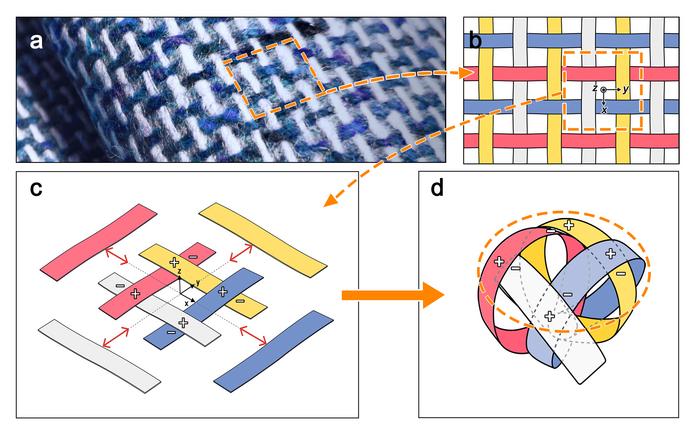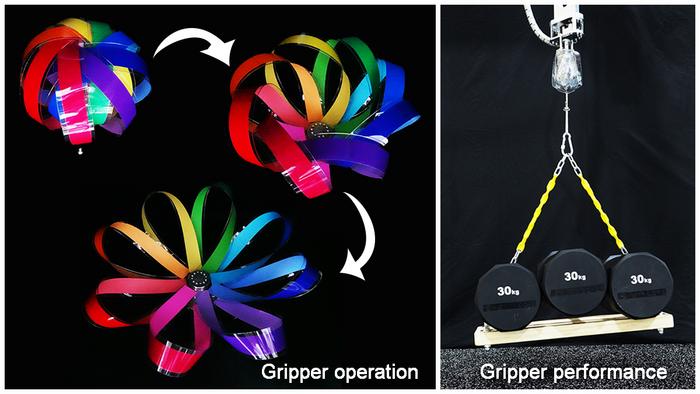| Oct 06, 2023 | |
A 130g soft robot gripper lifts 100kg? |
|
| (Nanowerk News) Soft robotic grippers, made from flexible materials like cloth, paper, and silicone, serve as robotic hands designed for safely grasping and releasing objects. Unlike their conventional rigid counterparts, these grippers offer greater flexibility and safety, making them ideal for household robots handling delicate items like eggs or logistics robots that manage diverse objects. However, they face challenges in lifting heavy items due to their low load capacity, and their grasp can be compromised with even slight external disturbances. | |
Key Takeaways |
|
|
|
|
 |
|
| Gripper schematic with weave structure. (Image: KIST) | |
The Research |
|
| Dr. Song, Kahye of the Intelligent Robotics Research Center at the Korea Advanced Institute of Science and Technology (KIST), along with Professor Lee, Dae-Young of the Department of Aerospace Engineering at the Korea Advanced Institute of Science and Technology (KAIST), have jointly developed a soft gripper with a woven structure that can grip objects weighing more than 100 kg with 130 grams of material. | |
| The research is published in Nature Communications ("Grasping through dynamic weaving with entangled closed loops"). | |
| To increase the loading capacity of the soft robot gripper, the research team applied a new structure inspired by textiles, as opposed to the conventional method of developing new materials or reinforcing the structure. The weaving technique they focused on involves tightly intertwining individual threads to create a strong fabric, which can reliably support heavy objects and has been used for centuries in clothing, bags, and industrial textiles. The team used thin PET plastic The grippers were designed to allow the strips to intertwine and unwind into a woven structure. | |
| The resulting woven gripper weighs 130 grams and can grip an object weighing 100 kilograms. Conventional grippers of the same weight can lift no more than 20 kilograms at most, and considering that a gripper that can lift the same weight weighs 100 kilograms, the team succeeded in increasing the load capacity relative to its own weight. | |
 |
|
| Gripper behavior and performance. (Image: KIST) | |
| Also, the soft robot gripper developed by the research team uses plastic, which costs only a few thousand won per unit of material, and can be used as a universal gripper that can grip objects of various shapes and weights, making it highly competitive in price. In addition, since the soft robot gripper can be manufactured by simply fastening a plastic strip, the manufacturing process can be completed in less than 10 minutes, and it is easy to replace and maintain, so the process efficiency is excellent. | |
| In addition to PET, which is the main material used by the research team, the gripper can also be made of various materials such as rubber and compounds that possess elasticity, allowing the team to customize and utilize grippers suitable for industrial and logistics sites that require strong gripping performance or various environments that need to withstand extreme conditions. | |
| "The woven structure gripper developed by KIST and KAIST has the strengths of a soft robot but can grasp heavy objects at the level of a rigid gripper," said Dr. Song. It can be manufactured in a variety of sizes, from coins to cars, and can grip objects of various shapes and weights, from thin cards to flowers, so it is expected to be used in fields such as industry, logistics, and housework that require soft grippers." |
| Source: Korea Advanced Institute of Science and Technology (Note: Content may be edited for style and length) |
We curated a list with the (what we think) 10 best robotics and AI podcasts – check them out!
Also check out our Smartworlder section with articles on smart tech, AI and more.

